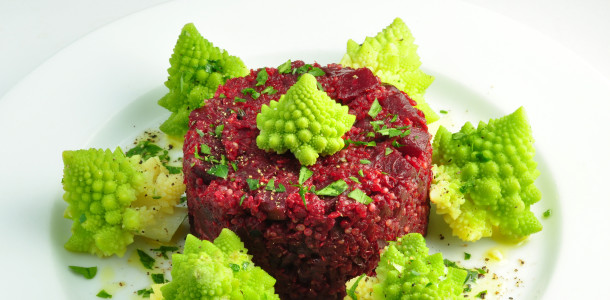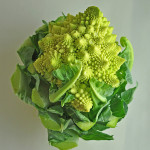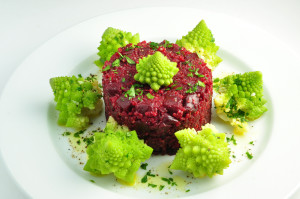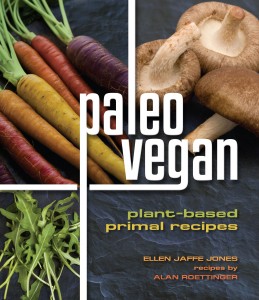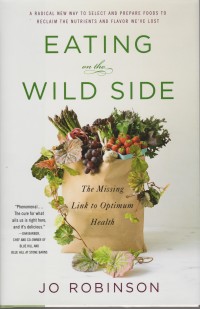In the introduction to Extraordinary Vegan, I made the following point:
“It’s been said that variety is the spice of life, but that’s not exactly right. Surprise is the spice of life—and the only certain cure for boredom. Variety is wonderful, and thankfully the world is bursting with it. But what pleasure would it offer if it never surprised us, stopped us in our tracks, stunned us with unexpected beauty? The same moon rises every evening, yet every so often it catches us by surprise, perhaps appearing larger, fuller, brighter, or with an unusual hue, and we are spellbound by it.”
I went on to explain the connection between surprise and what “extraordinary” is, in terms of food. All that is really required is a subtle shift, something unexpected, perhaps out of place, or previously unknown. It can also be a paradigm-shifting experience, of course, but that doesn’t often happen at the dinner table. The usual can easily be made unusual, surprising the senses, and I’m about to demonstrate this.
Take “Quinoa with Beets,” a dish from the same book, for example. The first time you sample it, a few things will happen. You might be struck by the color alone, or the textural complexity, or the layers of flavor. You will be surprised, and (I hope) delighted. Now you have this information, and perhaps you enjoyed the dish enough to want it again sometime. The next time, you may enjoy it almost as much, but the surprise will not be there. You may not care, because you’re enjoying the dish, but this time you will already know that three separate parts of the beet have been used, and unless something went wrong in the preparation, it should have all the same flavors and textures. No surprise.
Now consider the addition of just one new ingredient, plus a new presentation. This time, instead of merely scooping the quinoa with beets onto a plate or into a bowl, you pack it firmly into a ring mold, set in the center of the plate. You then carefully lift the mold away, leaving an attractive cylinder of the mixture. To decorate and further enhance the surprise, you add a few florets of romanesco cauliflower, steamed and tossed with a little oil, salt and pepper. As a final touch, you garnish with a bit of chopped parsley. If you’ve mastered the quinoa with beets (after making it just one time, I expect), this is a very quick, easily added step.
First, the quinoa part, just in case you don’t have Extraordinary Vegan (yet!) :
Quinoa with Beets
Makes 4 servings
I like using as much of a plant as possible, especially in the same recipe. The most striking visual aspect of this dish is the deep purple-red color, but what inspires me is achieving the illusion of three distinctly different vegetables from only one. There is the obvious beet, in large pieces; then the sliced stems, which most people have never eaten and might not be able to identify; and the green tops, which are easily confused with Swiss chard. The quinoa turns a bright amethyst color, and is sweetened by the beets. A complex effect is achieved with just two vegetables and a little thyme.
2 large beets, with green tops
1 cup white quinoa
1 unsalted vegetable bouillon cube
½ teaspoon sea salt
2 cups water
2 tablespoons extra-virgin olive oil
1 large red onion, diced
2 cloves garlic, minced
¼ teaspoon freshly ground black pepper
2 teaspoons chopped fresh thyme
Scrub the beets and cut them into 1 to 1 ½-inch pieces. Wash the greens and stems thoroughly. Remove the stems from the greens and cut them into ½ -inch lengths. Chop the greens coarsely.
Put the quinoa, bouillon cube, and 1/4 teaspoon of the salt in a small saucepan. Add the water and bring to a boil over high heat. Decrease the heat to low, cover, and cook for 20 minutes. Remove from the heat, fluff with a silicone spatula, replace the cover, and set aside.
Heat the oil in a large saucepan over medium-high heat until fragrant, about 30 seconds. Add the onion and cook, stirring frequently, until the onion softens, about 2 minutes. Add the beets and stir well. Decrease the heat to medium, cover, and cook, stirring frequently, for 10 minutes. Add the garlic, beet stems, remaining 1/4 teaspoon salt, and pepper and stir well. Cover and cook, stirring frequently, for 10 minutes. If the vegetables begin to stick, add a tablespoon of water as needed. When the beets are tender, add the quinoa and thyme, and stir well.
Carefully separate the florets from a head of romanesco cauliflower, using a paring knife to cut nice clean stems. They should be bite-size pieces. Put them in a steamer and stem them for about 7 minutes. They should be tender-crisp. Toss them quickly in a bowl with 3 tablespoons of Udo’s Oil (which I highly recommend).
Firmly pack a ring mold, set in the center of a dinner plate, with the quinoa and beet mixture. Gently lift the mold away. Surround the quinoa with the romanesco florets and place one in the center. Garnish with a little chopped parsley and serve at once.
Congratulations! You’ve just upped the ante on extraordinary and created surprise for someone!

